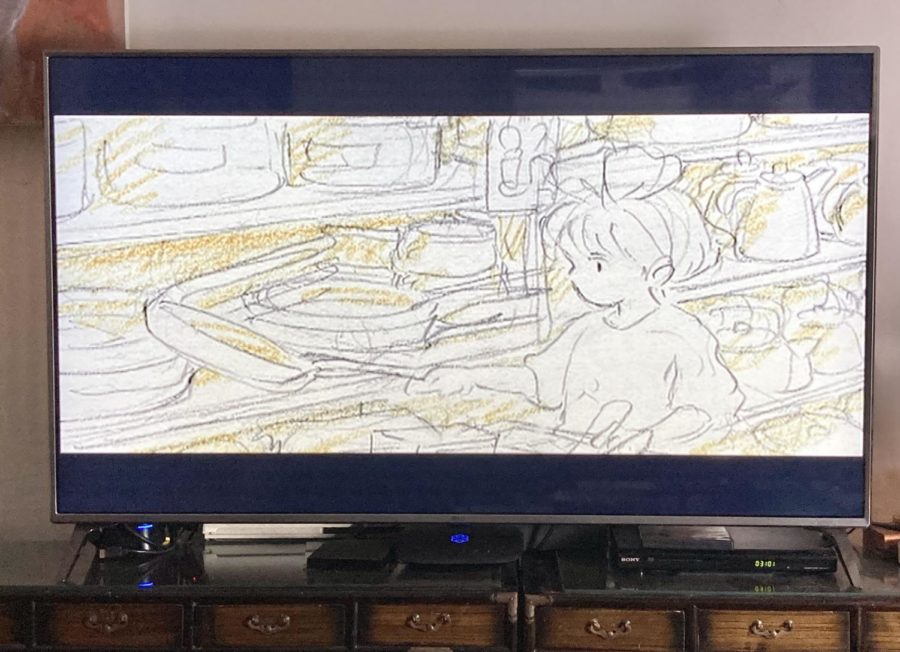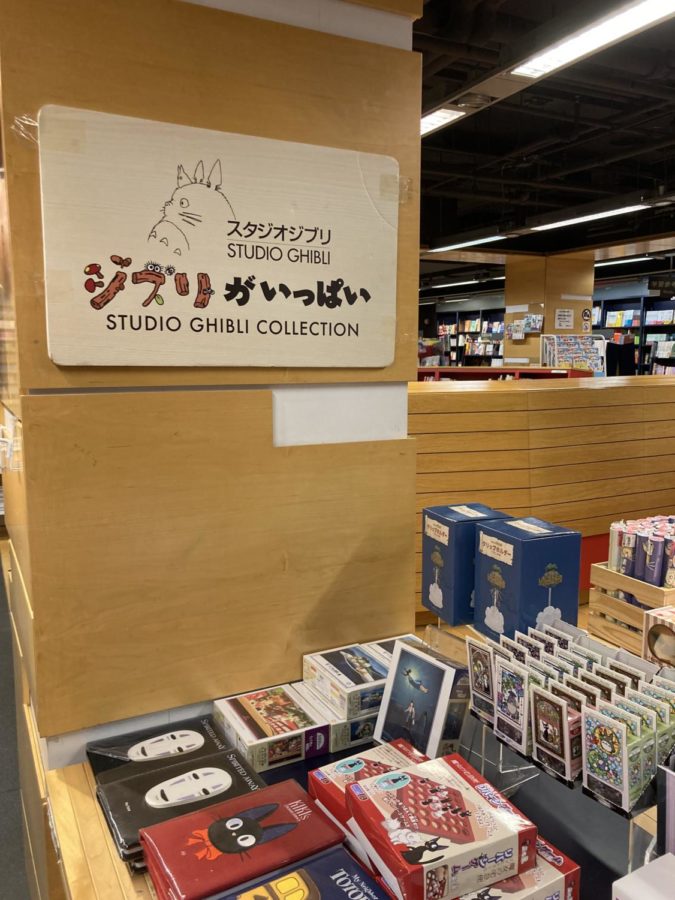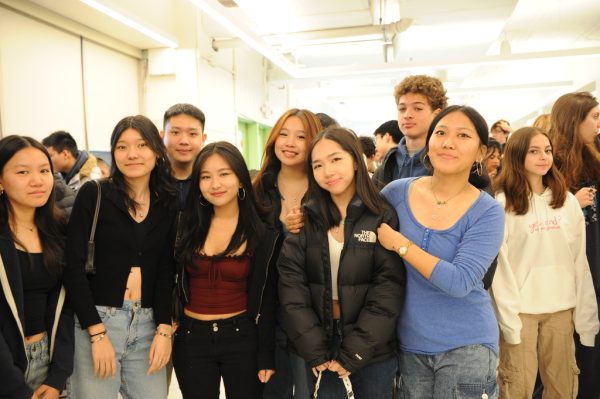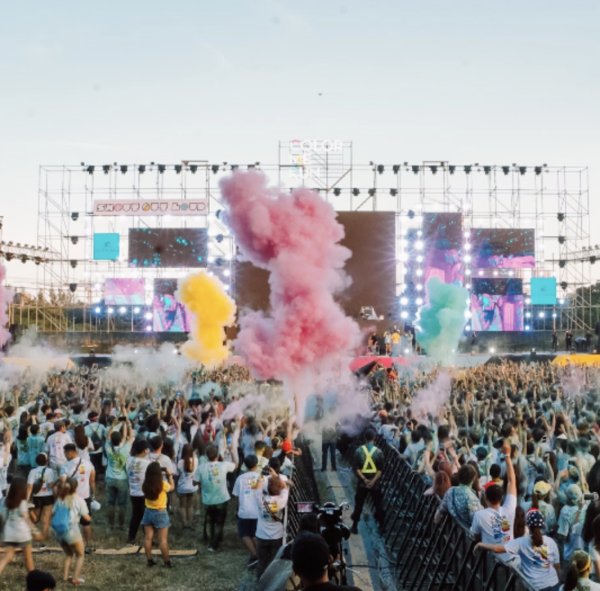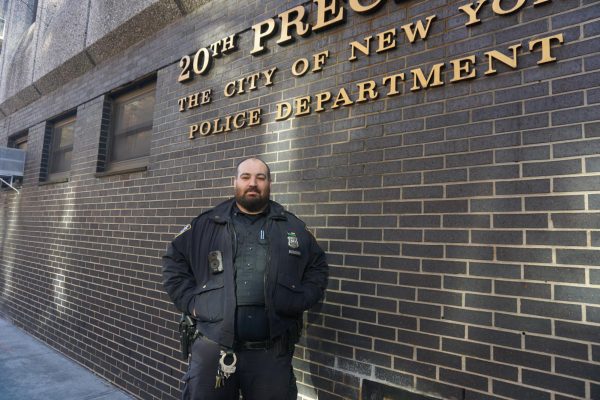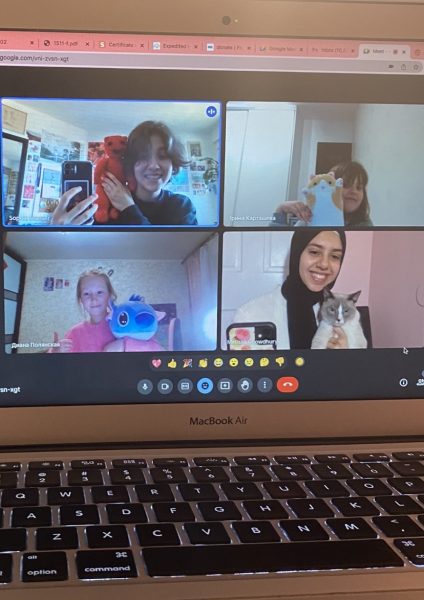The Beauty of Unrealistic Realism in Animation: An Appreciation of Studio Ghibli
Studio Ghibli, a Japanese animation studio, uses color and composition in order to connect to their audience beyond the screen.
The 1990s movie ‘Kiki’s Delivery Service’ includes the entire storyboard of the movie in graphite and green-colored pencil.
I am taken back to nearly a decade ago, sitting on the couch with my parents and my sister. Cold air is flowing through the window to our right, and the green trees outside are replicated on the screen as we switch on the television to watch Kiki’s Delivery Service. Kiki’s home in an alternate 1950s Europe is covered in vines and surrounded by flowers and trees. She yells for permission to take her father’s radio and whines about her dark purple dress, quickly saying her last goodbyes, before she takes off on her old broom to the sound of her bell and Yumi Arai on high volume.
Years later, as I re-watch my childhood favorite Studio Ghibli movies, I realize that I had no idea what was going on back then, but the colors were mesmerizing; the music and animation were enough to keep me entertained for hours on end.
Studio Ghibli is a Japanese film studio founded in 1985 by film directors Hayao Miyazaki, Isao Takahata, and Toshio Suzuki. Miyazaki is an internationally acclaimed storyteller who takes inspiration from world literature, including books by Roald Dahl and Antoine de Saint-Exupéry, who wrote The Little Prince. Over the past twenty years, the studio has accumulated numerous awards, and for good reason. Films typically have 24 frames per second, each carefully hand-drawn and compiled into a fantastical story shared across the world. Miyazaki believes that traditional hand-drawn is the fundamental of animation and it can best translate the movement of the characters and environments around them. Despite the shift to more modern forms of animation, Studio Ghibli’s notable slow-paced and detailed animation continues to immerse the audience in the films.
Benny Johnson, and elementary school literacy teacher and Studio Ghibli film lover for many years, said, “When Spirited Away came out in 2001, I remember about a year or two later, it was playing on STARZ, and I sat there out of boredom and watched the movie, and I remember getting closer to the screen as I watched it; the colors and the animation were so different from anything that I had ever seen even as an anime lover at the time. The ending left me feeling so happy, and I wasn’t sure why.” Johnson said that she finds herself incorporating the lessons from Studio Ghibli films into the classroom setting, helping students, especially young girls, understand that courage and intelligence and strength can look just like them. She hopes they can see themselves in these characters, so they can learn to make their own mistakes and to learn and grow from them.
The studio’s films shift focus on the characters’ mistakes and their flaws, as opposed to their strengths. Throughout the plot, the characters aim to better themselves, a trait that the audience may desire for themselves. It is these lessons that build the allure of the Ghibli movies and make them attractive to people of all generations.
Spirited Away, even just over twenty years after its release in August of 2002, has become one of the most popular Ghibli films. Chihiro, who has recently moved away from her friends and what she knows as home, is on her way to her new home and stumbles upon a tunnel with her parents. Through the tunnel and with her parents quickly transformed into pigs, Chihiro is stuck in a running bathhouse in the spirit realm, where she has to work under the demands of the bathhouse proprietor, Yubaba. She struggles through her unfamiliarity of cleaning floors and the rampage of spirit, “no-face,” to find her parents and return to the human realm.
“There are references to Japanese art, with the statues, temples, the city layout, and Ikebana; Shinto folklore; and also, Western art, such as Surrealism and caricatures,” said Mr. Giorgis-Blessent, an A.P. Art History teacher at Bronx Science, in response to motifs in the movie Spirited Away. Mr. Giorgis-Blessent also commented on the film’s references to global literature and cinema, with thematic parallels to works such as Lewis Carroll’s Alice in Wonderland, Carlo Collodi’s Pinocchio, and Vincent Minelli’s The Wizard of Oz. Each element in each scene including the main character, Chihiro, are very intentional, especially the motif of flowers, which cover her “like a tapestry and reveal little by little her nostalgic feelings,” as Mr. Giorgis-Blessent said. The use of color and composition is used expertly in the films, from the bright hues of a wizard’s magic to the dark and desaturated colors of a World War II safe house. Bright colors typically indicate a sense of vitality, action, and energy. Desaturated and more gray-scale colors, on the other hand, set up a somber and melancholy tone. Studio Ghibli changes these colors in order to evoke emotion from the audience by taking into consideration the standard color interpretations of the viewer and other forms of art.
Studio Ghibli films are appreciated by millions of people worldwide, who connect with the realistic aspects of their films and are entertained by the fantastical elements in them as well. Among the most popular of the studio’s films is Howl’s Moving Castle — a wholesome family story about love, acceptance, and loyalty. On the other hand, Grave of the Fireflies is renowned for other reasons. The film depicts the tragic journey of two siblings living in Japan during World War II. Despite obvious differences, the audience often finds themselves relating to and empathizing with them through their pain, love, desperation, and joy. The films reach out to the universal experience of emotion and tap into our sympathy, dreams, and memories. Whether that is the food of a loved one or the strangers who have changed one’s life, seldom are they completely untapped after pressing “play.”
Studio Ghibli films portray the struggles of people of all ages, recognizing universal experiences like the sickness of a loved one and the laughter that can be used to aid denial and wounds of grief. The directors of Studio Ghibli films show children overcoming obstacles, along with their natural curiosity, and their happiness in the unexpected. My Neighbor Totoro (1993), follows sisters Satsuke and Mei as they discover and befriend the spirits of their new rural home and wait for their mother to recover from her sickness at the hospital. Regarding the film, Hayao Miyazakio, the director of Studio Ghibli films, observed the expressions and habits of his friends’ children, which ensured that he could capture childhood joy in its entirety. Miyazaki did the same for Kiki’s Delivery Service, making sure to grasp the emotions of a pre-teen witch in a change of environment.
The detailed settings of the films are one way to translate the plot and the characters’ obstacles to those watching at home. Miyazaki draws from famous buildings and architectural styles around the world in order to inspire the design, history, and lore behind each story, and the intricate details of the characters.
Studio Ghibli’s Kiki’s Delivery Service, takes direct inspiration from Stockholm and Visby, two towns in Sweden with architecture that is mirrored throughout Kiki’s adventures. To capture the immersive feeling in the movie, Miyazaki and his team flew to Europe to photograph the town. Key elements like the clock tower, standing at 347 feet tall in Stockholm, old-fashioned street lamps, hanging metal signs, and thin alleyways are echoed throughout Kiki’s adventures.
Studio Ghibli films usually find a way to bring back memories that have been buried during the stresses of recent years. Cooped up in their homes for two years and in the heat of social and political issues, the teens of this generation are losing touch with their childhood. Following the quarantine period and the rise of the COVID-19 pandemic, students worldwide have become estranged from the ‘normal’ flow of their teen years. The Studio Ghibli films help aid the disconnect between people of all ages and their long-awaited reflection on childhood by reintroducing childlike wonder through fantastical realism. “A lot of my childhood was focused around Studio Ghibli. Their films will always have a special place in my heart,” said Sabrina Zhao ’26.
The beautiful animation, plot lines, and characters of Studio Ghibli films result in a series of works that embody life lessons, in order to teach a diverse audience that anxieties can be relieved, even if only for a few hours.
My aged DVD player has collected more dust and by now has seen dozens of living room re-decorations. To watch a movie on it is now an effort, but the DVD that I own of Kiki’s Delivery Service is timeless. I could sit there for the entire hour and forty-two minutes wrapped in a blanket, grinning until my eyes are closed shut and squinting at the screen, too engrossed to get up to grab my glasses that are only a few feet away.
To watch Studio Ghibli films on HBO Max (subscription required), click HERE.
Studio Ghibli films are appreciated by millions of people worldwide, who connect with the realistic aspects of their films and are entertained by the fantastical elements in them as well.
Tori Wee is currently a Features Editor for ‘The Science Survey.’ Tori finds that journalism is a means to creatively educate others through in-depth...

